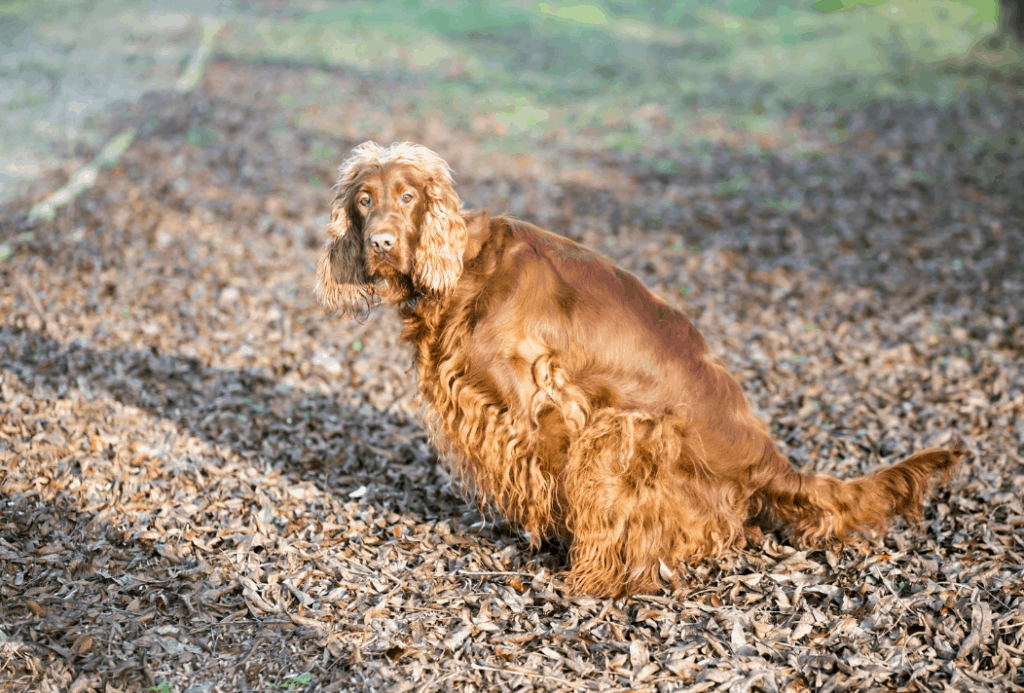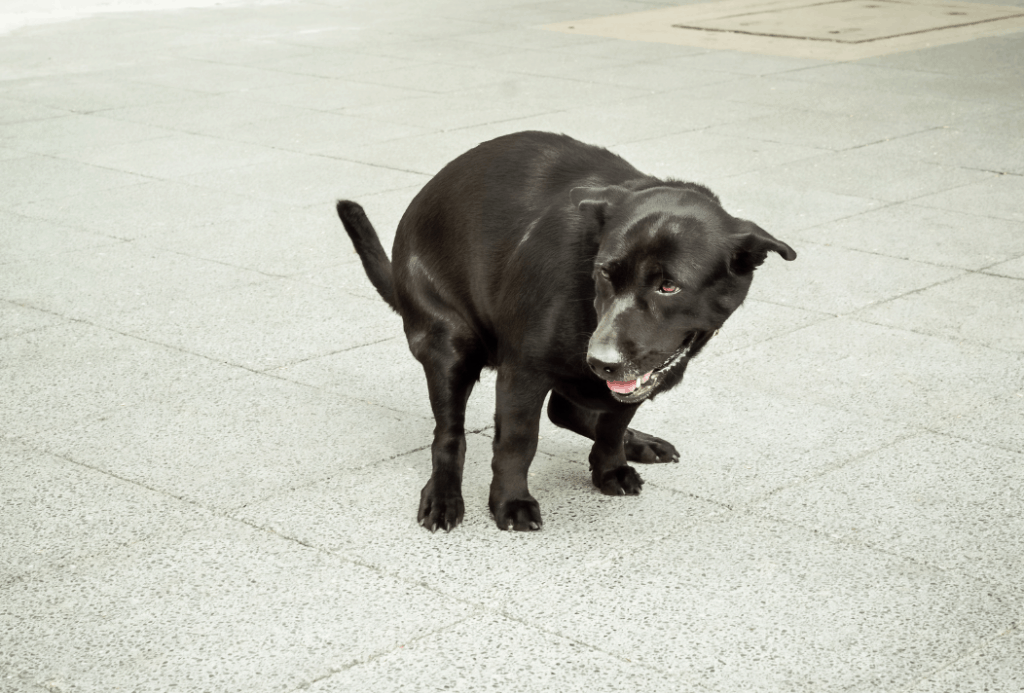Urinary Tract Infections in Dogs
Urinating in the house is a common reason for a veterinary visit. A urinary tract infection (UTI) may cause a sudden loss of housebreaking – because your dog really needs to urinate! While common, if left untreated, UTIs can lead to serious problems and continued discomfort for your dog.
Please note: If your pet is urinating in the house, it is important to take him to your veterinarian. Diagnostics can be performed to determine if this is due to a medical problem (such as a UTI) or a behavioral problem. Click here to learn about the common causes of both.

How do I know if my dog has a UTI?
Urinating frequently and in small amounts
Dogs with urinary tract infections most commonly urinate small amounts, frequently. Owners describe that their dog is needing to urinate constantly, but only small amounts of urine are voided each time. This is because the bladder wall becomes inflamed with a UTI; the dog feels the urge to urinate, even when the bladder is empty.
Sometimes, owners notice that their dog is urinating more, drinking more, and is not feeling well.
Urinating in the home or wrong spot
Housebroken dogs may begin to urinate in the house, which is also a common sign of several types of behavioral issues; testing is needed to differentiate between the two. It’s important to determine whether the change in behavior is due to a UTI or a behavioral issue.
Foul-smelling or cloudy urine
A urinary tract infection can cause foul-smelling or cloudy urine. Because of the inflammation in the bladder wall, blood may be present in the urine; it may look orange or red, or it may be a normal, yellow color.
Dogs may strain or appear uncomfortable when urinating
Urine may cause a burning sensation when passing through the urethra if an infection is present. Dogs with a UTI may be hesitant and posture several times before they urinate because they are anticipating pain. If your dog is straining, but not producing urine, he should be seen by a veterinarian immediately; this may be due to an obstructed urethra, which is an emergency.
Dogs with a urinary tract infection may lick their genitals
The vulva or tip of the penis may be red and irritated because the urethra is inflamed.

How do dogs get UTI infections?
The term urinary tract infection typically refers to a bacterial infection in the urinary bladder of the dog. If a urinary tract infection is not treated, it can spread to and cause an infection in the kidneys.
UTIs are categorized into two types: ascending or descending infections.
Ascending UTI infections
Ascending infections move from the external environment, up the urethra to the bladder. This may happen if there is dirt or debris in contact with the urethral opening.
Female dogs are particularly prone to urinary tract infections if they have a skin fold or fat fold covering the vulva, called a hooded vulva. The fold of skin keeps the vulva warm and moist, which is an ideal environment for bacterial growth.
Descending UTI infections
Descending infections may be contracted from pyelonephritis (infection in the kidney), which may have come from the bloodstream.
Certain medical conditions, including diabetes mellitus, or diseases that compromise the immune system may also lead to urinary tract infections. Fungal organisms can also cause UTIs, although this is uncommon. Uroliths (bladder stones) are a common cause of urinary tract infections in dogs.
What to expect for diagnostics
Urine testing
A urinalysis is the primary diagnostic tool to detect a urinary tract infection. The urine is placed on a urinalysis strip containing color change indicators that detect several things, including blood, white blood cells, glucose, and ketones. The urine is also examined microscopically or by a machine to identify cells (white blood cells, red blood cells, bladder wall cells, including cancer cells), casts, crystals, and organisms (bacterial and fungal). The combination of these test results will provide information to help diagnose a urinary tract infection, and may help to provide information about the cause.
Culture and sensitivity
Your veterinarian may recommend a culture and sensitivity. This test involves growing the bacteria that are present in the urine sample. The bacteria are then identified and exposed to many types of antibiotics to determine which are effective and which are not. Because this test requires bacterial growth, test results usually take about a week.
A culture and sensitivity requires sterile urine, a voided urine sample may be contaminated; a cystocentesis (a needle inserted directly into the urinary bladder) will likely be performed to collect a sterile urine sample for this test.
Additional Testing
Depending on the clinical signs and exam, your veterinarian may recommend additional testing. A radiograph (X-Ray) or ultrasound may be used to detect bladder stones or tumors. Blood work may be performed to identify other medical problems that could be contributing to the UTI.
Treatment of UTIs in dogs
UTIs usually do not clear up on their own so treatment is required. Treatment is based on the results of diagnostic testing.
Antibiotics
With an uncomplicated bacterial urinary tract infection, antibiotics are the mainstay of treatment. With a first time UTI, your veterinarian may prescribe antibiotics based on the type of bacteria seen microscopically.
Visual confirmation of bacteria allows for division into two major categories, based on shape. The shape of the bacteria will give your veterinarian an idea of which antibiotics are likely to be effective. Antibiotics may be changed based on the results of the culture and sensitivity.
Reduce pain and inflammation
Nonsteroidal anti-inflammatory drugs may also be prescribed to reduce bladder wall inflammation and pain.
Treatment for other conditions
Diagnostics may reveal a variety of other medical conditions that also require treatment.
How to prevent UTIs in dogs
The prevention of urinary tract infections depends,of course, on the cause.
- Increasing water intake and allowing your dog frequent trips outside to eliminate are helpful.
- Your veterinarian may recommend a prescription urinary diet that prevents or dissolves stones and crystals if they are present.
- Weight loss may be recommended for a female dog with a skin or fat fold that covers the vulva; in severe cases, an episioplasty may be needed to remove the fold of skin.
- Proper grooming and hygiene are important in any dog, especially around the genitals, to avoid infections.
What to do if you dog is getting recurrent UTIs

Recurrent urinary tract infections are frustrating for the owner and painful for the dog.
Your veterinarian will likely recommend additional diagnostics, including radiographs, blood work, culture and sensitivity, and ultrasound.
This will help rule out other conditions, including bladder stones, immunocompromisation, or bladder wall cancer that may be contributing to urinary tract infections.
Take your dog to your veterinarian at the first signs of a UTI
Urinary tract infections are common in dogs. They cause discomfort, which may lead to a housebroken dog urinating in the house, causing anxiety in a housebroken dog who is driven to please his owner. Take your dog to your veterinarian the first time you notice any signs of a urinary tract infection, to provide him relief and to prevent more serious problems.
The post Urinary Tract Infections in Dogs appeared first on VetBabble.





Post a Comment